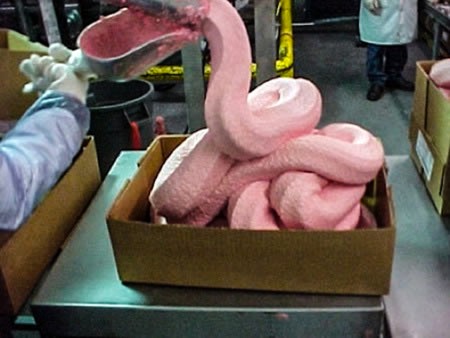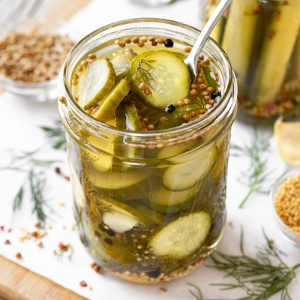All the chatter lately about the evils of ‘processed foods’ has raised some interesting questions. And conversations with friends and fans have prompted me to present my take on one of the most contentious: When does home food prep become ‘processing’?
 Pink Slime: ‘Mechanically deboned chicken protein’. Can be extruded, moulded;
Pink Slime: ‘Mechanically deboned chicken protein’. Can be extruded, moulded;
full of fat and salt; basis of products like Chicken McNuggets, Patties.
Could qualify for more than 1 NOVA ‘processed’ class.
Ultimate example of industrial processing…
It hadn’t occurred to me before, but does intensive home food prep constitute ‘processing’? Are ‘home processed’ foods safer to eat than factory-made and packaged foods? And if so, at what point do we draw a line?
What is processing?
Fortunately, the Canadian Heart Association helps us there, with its own definition. A Heart Association (CHA) guide for consumers defines food processing as ‘manipulation’ and/or ‘adulteration’ of basic foods. The result may be moderately to ultra-processed food products, or ingredients intended to make home prep or factory production of higher-level processed food easier and more consistent.
According to the CHA, there are 4 main classes of processed foods, as identified by the internationally supported NOVA program:
- Unprocessed or minimally processed foods: ‘Think vegetables, grains, legumes, fruits, nuts, meats, seafood, herbs, spices, garlic, eggs and milk. Make these real, whole foods the basis of your diet.’
- Processed culinary ingredients: These are substances obtained directly from group 1 foods or from nature by processes such as pressing, refining, grinding, and milling.
Group 2 items are rarely consumed in the absence of group 1 foods. Examples are salt mined or from seawater; sugar and molasses obtained from cane or beet; honey extracted
from combs and syrup from maple trees; vegetable oils crushed from olives or seeds; butter and lard obtained from milk and pork; and starches extracted from corn and other plants. - Processed foods: When ingredients such as oil, sugar or salt are added to foods and they are packaged, the result is processed foods. Examples are simple bread, cheese, tofu, and canned tuna or beans. These foods have been altered, but not in a way that’s detrimental to health. They are convenient and help you build nutritious meals. Life Lesson: Not everything in a package is bad for you!
- Ultra-processed foods: Here’s the category where almost 50 percent of our daily calories come from – and where we should cut back. These foods go through multiple processes (extrusion, molding, milling, etc.), contain many added ingredients and are highly manipulated. Examples are soft drinks, chips, chocolate, candy, ice-cream, sweetened breakfast cereals, packaged soups, chicken nuggets, hotdogs, fries and more.
The current conversation…
Okay. Given the above, here’s the big question: Where do home-processed foods fit into this scheme of things?
What are ‘home processed foods’?
By ‘home-processed’, I mean a sort of cross between NOVA classes 2 and 3: Pickles and preserves; home-made baby foods; whipped cream, peanut butter mayonnaise; marinated and fermented foods. Also, home-made condiments and ‘culinary ingredients’ such as ketchup and prepared mustard, traditional herb and spice masalas (especially wet preparations like Thai Curry paste, harissa, and sriracha). What about foods eaten as sides and accompaniments such as, hummus, tabbouleh and salsas?
Why consider these more than minimally processed?
All the above are not only heavily manipulated in appearance, flavour and texture, but traditionally get a lot of added salt and/or sugar. Some traditional recipes handed down from generation to generation also call for preservatives, such as tartaric acid (cream of tartar), citric acid, vinegar, curing salt, sulphites (common in home wine making) and other so-called ‘natural preservatives’.
Parallel but directly connected
In a completely different discussion, we could talk about canning/bottling, pit smoking, and dry curing. Here is where we’re getting into the category of packaging – another important consideration when analysing how highly processed a food is.
Without further brain teasing
I invite you to muse on that…
~ Maggie J.

